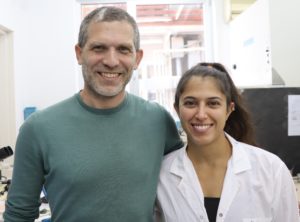Tel Aviv University scientists have developed a new technology that allows robots to smell using a biological sensor. This is possible after the research team found a way to use real insect sensors to detect nearby odors and transmit them as electrical signals to computers that identify and interpret them.
Referring to human-developed devices, “our ability to smell with electronic sensors is very limited,” Dr. Ben Maoz of the Fleischman Faculty of Engineering and the Sagol School of Neuroscience at Tel Aviv University, one of the researchers that led the technological and biological breakthrough, told The Media Line.
Cameras can identify light very well, and microphones can identify sound very well, said Maoz, “but if you look at the identification of smell, actually we are not very good at doing it using electronic tools.”
The technology is simple, he says. “We take the biological ‘nose’ of the insect, and we use this as our sensor. This is a real biological nose that is integrated with the robot using two electrodes,” he explained.
Professor Amir Ayali of the School of Zoology and the Sagol School of Neuroscience, and another researcher on the project, told The Media Line that this bio-hybrid approach is a major step in the evolution of technology, as it allows humans to overcome obstacles that may seem extremely challenging otherwise; “for example, developing successful olfactory sensors.”
Maoz says that insects use their sense of smell to survive. “They need to smell flowers, they need to smell predators, and we are not even close to these capabilities with today’s electronical tools,” he said.

Dr. Ben Maoz of the Fleischman Faculty of Engineering and the Sagol School of Neuroscience at Tel Aviv University and doctoral student Neta Shvil. (Tel Aviv University)
Maoz, Ayali, Professor Yossi Yovel of the School of Zoology and the Sagol School of Neuroscience, and Neta Shvil, a doctoral student at the university, “teamed up and said let’s try to take the antenna of the insects to basically use it as a smell identification sensor,” according to Maoz.
This development can help humanity in many ways, Maoz says. One example is the way in which dangerous or illegal substances are discovered at the airport. There are tools such as magnetometers to detect metals, but when it comes to detecting the smell of drugs or explosives, animals are used.
Animals have extremely sensitive smelling capabilities that are often used to identify drugs, explosives and rotten food, Maoz explained. Specific animals can even identify diseases, he added.
“Imagine that we can have this sniffing device that will be able to identify if you have a specific disease just by smelling your breath,” he said.
Regarding the choice to use insect sensors for the technology instead of other animals, Ayali explains that, in bio-inspired technological innovations, insects are often chosen as the source of inspiration as they constitute the largest group of living organisms, and present various characteristics that are advantageous for such technologies.
“They live in varied environments and, hence, demonstrate diverse adaptations. They are also of small size, agile and fast-moving creatures, all major advantages for technology,” he said.
Specifically for the Tel Aviv University scientists’ bio-hybrid applications, Ayali said that: “Insects are a preferred choice as their sensors are usually easy to dissect, small, lightweight and energetically efficient, while also excelling in sensitivity and robustness.”
Maoz says that the scientists are trying to use their sensitive bio-hybrid for different applications. “Currently, we have tested our system on 20 different smells, but we already started to work with different companies who are really interested in specific applications,” he noted.
Ayali stresses that, while the project is still in the early stages, the research team is already dealing with various governmental and commercial entities that have showed great interest in harnessing the technology. Any application that may come to mind involving the need to detect, identify and/or locate a source of odor is relevant.
The results of the study were published in the peer-reviewed scientific journal Biosensor and Bioelectronics.
The research is still moving forward and the scientists should soon be able to report further progress in incorporating the technology with a small robotic platform, Ayali added. “This involves further challenges like navigation, communication algorithms and more,” he said.